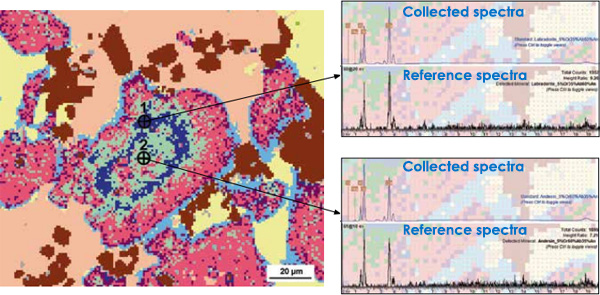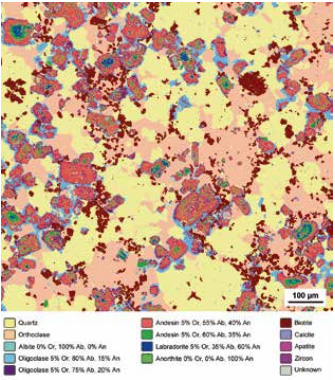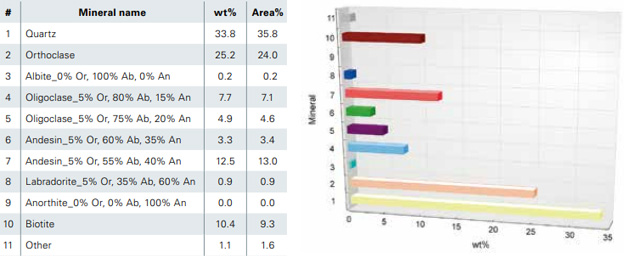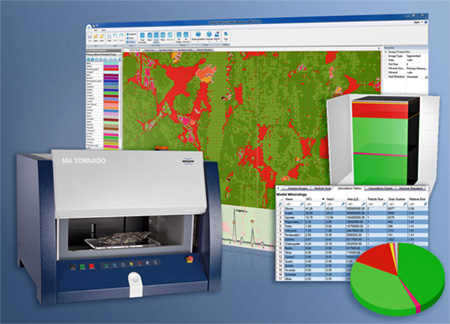Analyse Mineral Composition in Geology and Mining with Micro-XRF
How to analyse mineral composition with micro-XRF, to understand the origin and formation of rocks in geoscience. This information is useful in various fields of geology and mining, including aluminium, steel, gold and diamonds.
Blue Scientific is the official distributor for Bruker Micro-XRF in the UK, Norway, Sweden, Denmark, Finland and Iceland. For more information or quotes, please get in touch.
Bruker Micro-XRF instruments
More about geology and geoscience
Contact us on +44 (0)1223 422 269 or info@blue-scientific.com
Follow @blue_scientificGenerate Mineral Maps
With the Bruker M4 TORNADOAMICS (Advanced Mineral Indentification and Characterisation System) you can collect XRF (X-Ray Fluorescence) spectra and generate mineralogical maps. These mineral maps can be used to gain insights into:
- Modal abundance
- Calculated assay
- Mineral association
- Textural aspects
- … and more
How it Works
X-ray fluorescence spectra are collected by exciting the sample with an X-ray beam. The spectra indicate the mineral’s specific chemical composition (or composition range). They can be used to identify the mineral, like a fingerprint.
The spectra are then compared to an extensive library to identify the minerals.

Example: Feldspar Zonation in Granite
In this example, the M4 TORNADOAMICS was used to study the zonation of plagioclase feldspar in granite.
Identifying the species of feldspar is part of igneous rock classification. Variations in the composition of feldspar crystal (zoning) can provide information about the crystallisation history of the magma.
A granite slab (16 cm x 10 cm) was analysed with the Bruker M4 TORNADOAMICS. The sample was provided to Bruker by Dr. Toru Shimizu and Dr. Nobuo Geshi of the Geological Survey of Japan, AIST.
First an overview of the sample was taken, consisting of a mosaic of several images to cover the complete surface. An area of interest was then selected (1000 x 1000 pixels).
The measurement time was 5 hours and 49 minutes. This is longer than when analysing elements with micro-XRF, because a higher number of counts is required to match the spectra – in this case 1800 counts for the quartz.
Identifying Minerals
The spectra were then matched to a reference library. Any unknown phases can be assigned by creating clusters of spectra with various parameters.

An array of synthetic plagioclase composition was added to the reference list, to identify zoning in plagioclase from Ca-rich cores to Na-rich rims.
The modal mineralogy is shown below. “Other” consists of the minerals calcite, apatite, zircon and any remaining unknown phases.

Applications
This information can be used in various areas of geology, geoscience and mining:
- Understand the earth’s processes
- Study rock history
- Locate potential economically viable deposits in mining
Advantages of Micro-XRF
Micro-XRF is a practical screening tool that complements other high resolution techniques:
- Minimal sample preparation – all you need is a reasonably flat surface
- Identify variations in mineral composition with confidence
- Extensive database of minerals
- Cluster spectra according to various parameters

Bruker M4 TORNADOAMICS
- Large chamber for rock slabs, drill cores and thin sections
- Little or no sample preparation
- Automate runs of multiple samples
- Micrometre resolution
More Information
Blue Scientific is the official UK and Nordic distributor of Bruker Micro-XRF. We’re available to answer all your questions – just get in touch:


